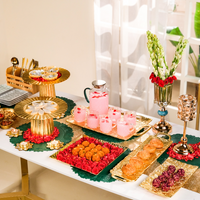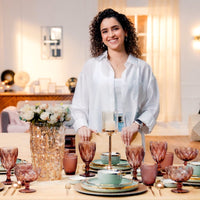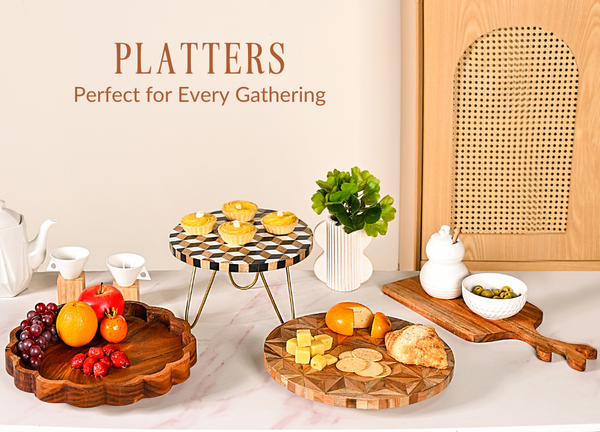When you’ve just taken your favourite soup off the stove and are ready to serve it at the table, you’ve probably wished you had a trivet handy. Yes! It’s that one essential your mum always reminds you to put on the dinner table before she brings out any piping-hot dish.
Trivets have long been very essential in kitchens around the world, serving the simple yet essential purpose of protecting countertops and dining tables from heat damage caused by hot pots, pans, and dishes. Traditionally seen as purely functional items, trivets act as a heat-resistant barrier, preventing burns, scorch marks, and surface stains while ensuring your cookware can be placed safely anywhere.
 With the DIY culture, trivets have evolved to become versatile and stylish additions to home decor. Available in a variety of materials, they offer endless opportunities to inject personality, texture, and visual interest into your living spaces.
With the DIY culture, trivets have evolved to become versatile and stylish additions to home decor. Available in a variety of materials, they offer endless opportunities to inject personality, texture, and visual interest into your living spaces.
This blog will explore innovative and creative ways of using trivets to add an accent to your living spaces. However, many people often confuse trivets with tea coasters and placemats. So, let’s clear the air and understand the differences between these three:
|
Feature |
Trivet |
Tea Coaster |
Placemat |
|
Primary purpose |
Protects surfaces from heat damage caused by hot pots, pans, or dishes |
Protects table surfaces from heat rings, moisture, or stains caused by cups/glasses |
Protects table from heat, spills, and scratches from plates, cutlery, or serving dishes |
|
Size |
Medium to large: enough to hold cookware or serving bowls |
Small: sized to fit under a cup or glass |
Large: sized to hold an individual plate setting |
|
Heat resistance |
High: designed to handle extreme heat |
Moderate: handles hot beverages but not cookware-level heat |
Moderate: handles warm plates but not direct cookware heat |
|
Placement |
Centre of dining table, countertops, or kitchen island |
Under cups/glasses |
Under each dining plate setting |
|
Usage Scenario |
Placing a hot casserole pot or pot directly from stove/oven |
Resting a hot tea/coffee cup or cold drink glass |
Setting a full dining plate with cutlery for a meal |
Now that we have a clear idea, let us dig into 11 amazing ways of restyling a trivet:
1. Planter Display Stands: Give your indoor plants a stylish boost by placing small potted plants on trivets. Not only does this protect your furniture from water damage and soil spills, but it also adds height and dimension to your plant arrangement. Using trivets as planter stands can help create a layered look that feels curated and intentional, adding charm to any green corner.
2. Wall-Mounted Art Statement: Some trivets, like our Pearls Decorative Round Trivet, aren’t just table protectors; they double as stunning wall decor. Hang them up to create a unique art statement that adds texture, elegance, and becomes a conversation starter to your space.
3. Festive Accent Pieces: Rotate seasonal trivet styles, like warm-toned ceramic pieces, as bases for festive decor items during holidays to level up seasonal styling.
4. Bar Cart or Entryway Tray: Use the pearl-trimmed or vibrant ceramic trivets as bases for drink decanters or catch-all trays in your entryway or bar cart, combining function with decorative purpose.
5. Rustic Centrepiece Base: If you have trivets of natural textures, such as our Round Sabai Trivet, you can use them as a redefined centrepiece base for a more rustic look. Its earthy tones create a charming, rustic foundation for vases or bowls; therefore, a perfect choice for a warm and organic table centrepiece.
6. Mini Shelf Decor: Open shelving is a great way to showcase your style, and trivets can play a key role here. Place trivets under decorative items like jars, figurines, or ceramics to define their space and create visual cohesion. This layering technique helps to break up the shelf visually while adding an element of texture that keeps your display interesting and polished.
7. Entryway Accent: Your entryway is the perfect spot to showcase stylish and practical decor. Place a decorative trivet on your console table to hold keys, small bowls for change, or a cluster of candles. This adds a touch of charm and organisation right where you need it most, making your home feel welcoming and thoughtfully curated from the moment guests walk in.
8. Open Kitchen Display: Hang trivets on hooks or prop them up on open shelves to bring decorative interest into your kitchen. This allows you to keep them handy while also turning them into charming decor elements. Trivets with beautiful patterns or vibrant colours, like the Jute Trivet Mat With Wooden Beads, can enhance your kitchen’s personality and create a warm, lively feeling.
9. Bedside Table Styling: Trivets aren’t just for the kitchen! Place a sabai or a colourful jute trivet on the bedside table of your guest room to create a luxe, traditional look. Use it as an elegant coaster for nighttime tea, a scented candle, or a small vase of fresh flowers. This simple addition adds texture and style while protecting furniture from heat or spills, making your guest space feel warm, inviting, and thoughtfully curated.
10. Mini Shelf Decor: Open shelving is a great way to showcase your style, and trivets can play a key role here. Place trivets under decorative items like jars, figurines, or ceramics to define their space and create visual cohesion. This layering technique helps to break up the shelf visually while adding an element of texture that keeps your display interesting and polished.
11. Snack Tray for kids: Perfect for little hands, some fun trivets like our Butterfly Gardenia Platter can serve as a cute, safe snack tray during story time or playdates, keeping snacks tidy and easy to carry.
Therefore, it is established that from protecting surfaces to serving as wall art or plant stands, trivets offer countless creative uses beyond their traditional role. Whether as festive accents or bedside coasters, they bring warmth and texture to any space.
Happy reimagining spaces!
























